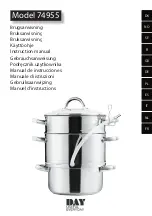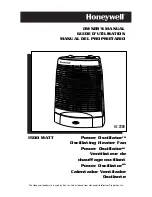
Install and remove
float valve.
When pressure builds up inside your
cooker, the float valve pops up. This
indicates the cooker is pressurized
and prevents you from opening the
lid. When the cooker is depressurized,
the float valve drops down.
Note:
Refer to
Venting
methods section of
this user guide to safely release pressure.
Remove:
Place one finger on top of
the float valve (located in the upper
part of the lid) and turn lid over.
Detach the silicone cap from the float
valve and remove float valve from
top of lid.
Note:
Always keep the float valve and
silicone cap in a secure place after
removing from the lid.
Clean float valve
to remove dried food debris after every
use to avoid clogging. The float valve and
silicone cap must be installed in the lid
before operating your cooker.
Install:
Insert float valve on the hole
located on top of the lid. Place one
finger on the float valve and turn lid
over. On the bottom of lid, attach the
silicone cap to the float valve.
Note:
The float valve and silicone cap must
be installed in the lid before operating your
cooker.
Warning:
Never touch the float valve
while the cooker is pressurized to avoid burns.
NOTE:
Always ensure that pressure release valve is in
Sealing
position for all pressure
cooking programs -
Soup, Bean, Meat, Egg, Cake, Rice, Biryani, Oatmeal, Steam, and
Pressure Cook.
When using
Slow Cook, Yogurt
and
Keep Warm
functions, pressure release valve must
be in
Venting
position.
Install and remove
pressure release valve.
Install:
Position pressure
release valve on pressure
release hole and press down.
*NOTE:
The pressure release valve
automatically releases pressure if
excessive pressure builds up inside your
cooker.
Remove:
Pull pressure release
valve up from pressure release
hole.
Pressure release valve must be
installed before use and cleaned
frequently.
*NOTE:
Be aware that pressure
release valve fits loosely when properly
installed. It will safely remain in place
even if lid is flipped over.
remove
(pull vertically)
install
23
22













































